I'm studying rigid body motion on Landau but I'm having troubles to understand this proof of the fact that the angular velocity $\vec{\Omega}$ is constant for a rigid body.
My doubt is about the two last equations in the last two lines of the text. If I use the two I get
$\vec{V'}=\vec{V}+(\vec{\Omega}-\vec{\Omega'})\times \vec{r'} +\vec{\Omega} \times\vec{a}$
How are (31.3) derived from this?

